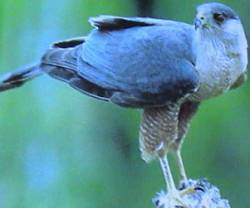Coopers Hawk
|
|
| Cooper's Hawk | ||||||||||||||
|---|---|---|---|---|---|---|---|---|---|---|---|---|---|---|
 | ||||||||||||||
| Scientific classification | ||||||||||||||
| ||||||||||||||
| Binomial name | ||||||||||||||
| Accipiter cooperii (Bonaparte,, 1828) |
The Cooper's Hawk, Accipiter cooperii, is a medium-sized hawk.
Adults have short broad wings and a long round-ended tail with dark bands. They have a dark cap, blue-grey upperparts and white underparts with red bars. They have red eyes and yellow legs. Adult females are much larger. This bird is somewhat larger than a Sharp-shinned Hawk, but smaller than a Northern Goshawk. It appears long-necked in flight.
Their breeding habitat is forested areas across southern Canada, the United States and northern Mexico. They build a stick nest in a large tree.
In most of the United States, they are permanent residents. Northern birds migrate to the southern U.S. and Mexico.
These birds surprise and capture small and medium-sized birds from cover or while flying quickly through dense vegetation. They also eat small mammals such as squirrels, sometimes lizards, frogs, snakes and large insects. They often pluck the feathers off their prey on a post or other perch.
This bird was named after the naturalist William Cooper, one of the founders of the New York Museum of Natural History.
